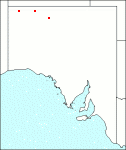Family: Poaceae
Enneapogon clelandii
Citation:
N. Burb., Proc. Linn. Soc., Lond. 153:80 (1941).
Synonymy: Not Applicable Common name: Clelands nineawn. Short-lived perennial c. 50 (rarely 31-85) cm; culms branched, glabrous or the lower internodes hirsute to pubescent; blades involute, finely pointed, glabrous or pilose, scaberulous.
Description:
Panicle 1.5-3 (rarely to 6) x 1-1.5 cm, compact, linear or lanceolate to elliptic or oblong; axillary inflorescences and spikelets absent; spikelet 4- or 5-flowered, with 1 floret fertile; glumes membranous, 2.3-4.8 mm long, 3-7-nerved, lanceolate or oblong to ovate or elliptic, obtuse, entire or erose; lowest floret: lemma body 2-3.5 mm long, membranous, with ribbed nerves, bearded with hairs from two-thirds to as long as the body itself, ciliate on the margins; awns 2.5-3.5 mm long, similar in width, 1-nerved; palea body hairy all over or glabrous near the base and the apex; flaps long-hairy; keels long-ciliate in the upper half; grain 1.3-1.6 x 0.6-0.9 mm, narrowly obovoid or ellipsoid; second floret: lemma lightly ribbed, glabrous; palea hairy; rhachilla glabrous.
|
|
Distribution:
|
W.Aust.; N.T.; Qld.
|
Conservation status:
native
Flowering time: throughout the year.
|

SA Distribution Map based
on current data relating to
specimens held in the
State Herbarium of South Australia
|
Biology:
Moderately palatable but seldom common enough to be of significant value.
Author:
Not yet available
|

